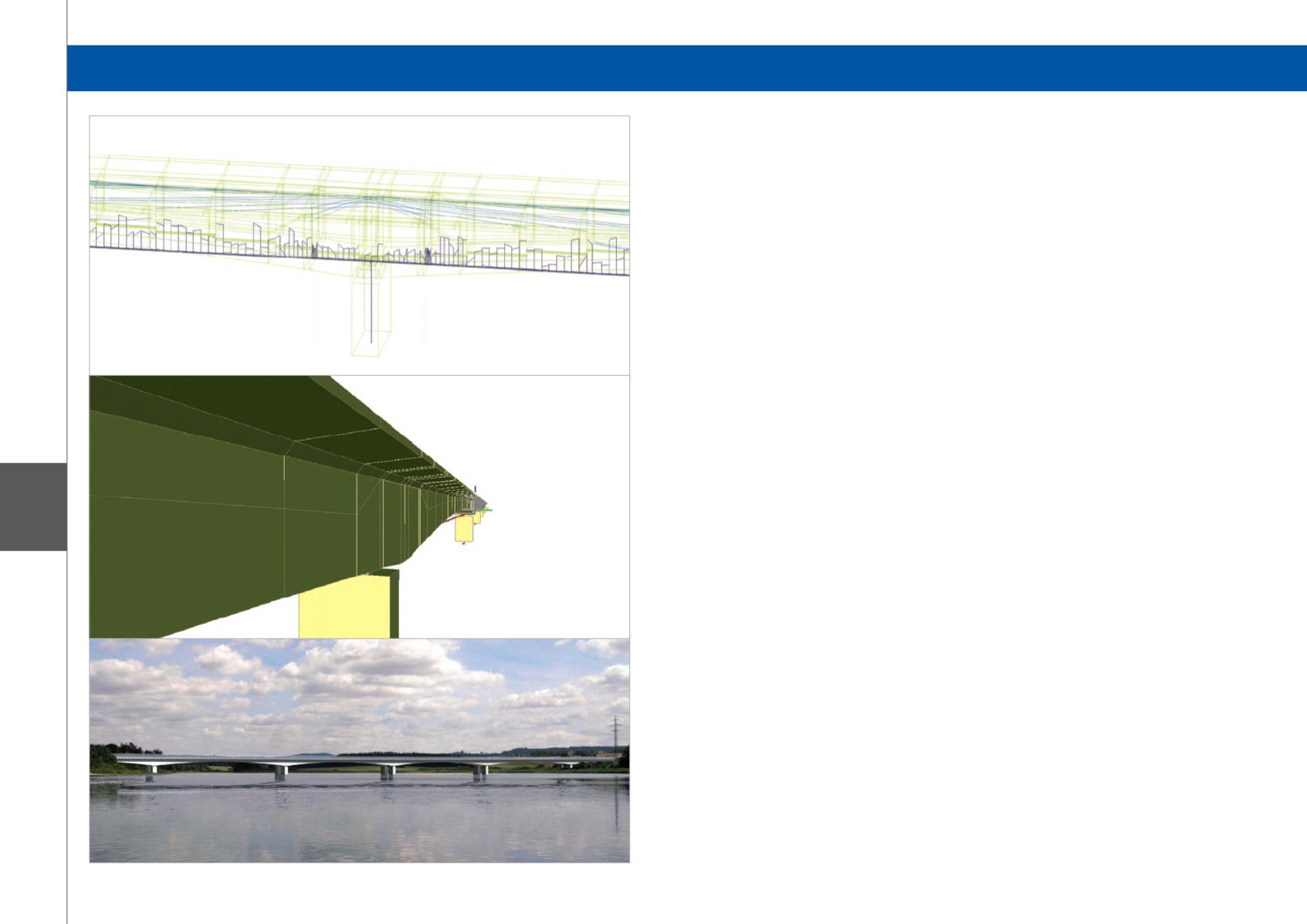
138
X2
Category 2: Civil Structures
The Bridge over Koberný lake and a wildlife corridor at the
87,500 km point of the D3 motorway section running from
Tábor to Veselí nad Lužnicí, with a total length of 552.8 m
(58.4 + 4 x 109.0 + 58.4), is located in a non-built-up area,
within the meliorative area of Koberný lake, about 15.4 m
above the terrain surface. It is located approximately two
kilometres south-east of the town of Planá nad Lužnicí,
and about one and half kilometres north of the village
of Košice. The valley which is traversed by the bridge is
used for agricultural and breeding purposes.
The D 27.5/120 width configuration motorway bridge
is set to a right-hand horizontal curve with the radius
R = 1,750 m and in vertical alignment is on a vertical
curve with the radius R = 35,000 m. Transversally, the
roadway on the bridge is superelevated at 3.5 %.
The C 30/37 XF4 concrete grade pillars, with the cross-
section of 8.0 x 2.5 m, are founded on 19 thirty-metre
piles 1.2 m in diameter. The piles are keyed into R3
and R4 paragneiss to the depth of about 1.5 m. Under
abutments and in the transition area, the ground is
reinforced with gravel piles, allowing for the effect of the
settlement of adjacent embankments with the average
height of 12 m. According to calculations, the aggregate
settlement of the adjacent embankments reaches up
to 0.6 m. The abutments are founded on 10 deep piles.
Water encountered during drilling for the piles was
pumped to settling tanks behind the abutment to be
liquidated in an environmentally friendly way.
Two pairs of casting carriages were used for the free-
cantilever-method construction of the load-bearing
structure of the box girder with the variable depth
ranging from 2.69 m to 5.89 m. Casting of the girder
proceeded symmetrically from 16-metre long balance
arms. The stub was cast at two stages, on a scaffold
provided by PIŽMO supports. Four temporary reinforced
concrete supports with the cross-sections of 1.3 x 1.3 m
were tied for stabilising the balanced cantilevers on
each foundation. The stub in the assembling condition
was with the foundation for each temporary support
in relation to a pair of pre-stressing rods 47 mm in
diameter. After the joints of the neighbouring stubs
were made monolithic, all the temporary supports were
deactivated.
Several mathematical models for apposite computational
analysis of the structure during all the stages of the
construction process were created in Scia Engineer.
Calculations were realised with a global and local finite
elements model using beam and (or) plate elements.
Because of a great computational demand, or sometimes
the poor relevancy of global models, some details of the
structure and some phases of the construction have been
modelled and calculated in separate models. Two global
models were created. The first one - a 3D model, which
consists of 1D members in proposed geometry - was
made for clarification of the torque, for the assessment of
inner forces from support settlement, the superimposed
dead load and climatic effects, and for determination
of the bearings load. The second one is a 2D flattened
model which consists of 1D members. It was made for
time dependent analysis. The model reflects the rheology
and loading history for the assessment of inner forces and
deformations in specific time. For the shape modelling,
the 1D member modeller was used with a Variable cross-
section, General cross-section and Planar 2D members.
Concrete designer modules were used for better time
dependent behaviour understanding e.g. Post-tensioned
tendons, a Prestress check and Time dependent analysis.
The global analysis model is a 3D frame TDA model with
beam elements respecting the proposed geometry. Cross-
sections that are 1D member are defined as general
cross-sections with a linear-variable connection. The
piers are 1D members with a constant cross-section. The
foundation details are calculated separately and in the
global model are represented as an elastic support. The
tendons are modelled using a Post-tensioned tendons
module aid. Cantilever tendons in the upper plate of the
deck and continuous tendons are applied as 1D member
in real proposed geometry or in a flattened shape in a
TDA model. The bearings are simulated as short 1D
member with joints with specific material characteristics.
In TDA a relevant displacement is released in a specific
time. Temporary supports are rigidly connected to a
balanced cantilever and in TDA they are also removed in
specific time. The computation of inner forces is carried
out with a standard linear calculation.
Bridge over Koberný Pond and a Wildlife Corridor at km 87,500 of D3 Motorway - Soběslav, Czech Republic
Software: Scia Engineer


